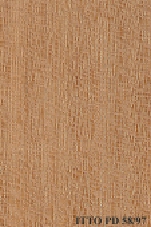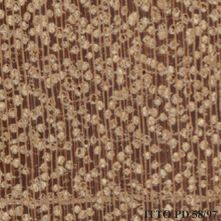
KAPUR (Dryobalanops lanceolata)
Trade Name
Kapur
Scientific Name
Dryobalanops lanceolata Burck
Family
Dipterocarpaceae
Common Names
Kapoer (Netherlands); Kapur (Sabah); Indonesische kapur (Germany); Kapur (Sarawak); Oost-Borneo kamfer (Netherlands); Indonesisk kapur (Sweden); Capur indonesiano (Italy); Capur indonesiano (Spain); Swamp kapur (Sabah); Borneo camphorwood paigie (Sabah); Kapur (Malaysia); Capur d`Indonesia (France); Kapur-kejatan (Malaysia); Petanang (Indonesia); Kapur tanduk (Indonesia); Indonesian kapur (United States of America); Keladan (Malaysia); Indonesian kapur (United Kingdom)
Description Of The Tree
Botanical Description
This camphor tree is very large, occasionally up to 75 m tall, with a straight bole, branchless for 35 m or more, and having a diameter of up to145 cm and buttresses of up to 4 m high and 3 m long.
Natural Habitat
Dryobalanops lanceolata is the tallest recorded dipterocarp tree. Kapur timber fetches the highest prices in Borneo and the species is also a major source of Borneo camphor. It grows on fertile clayey soils up to 800 m of altitude.
Non Timber Uses
Brittle heart is occasionally reported for this species. It contains chemicals that discolor ferrous metals when damp.
Wood Identification
Anatomic Description Of Wood
Wood diffuse porous. Vessels exclusively solitary (over 90%). Tangential diameter of vessel lumina 200 micras or more (large). Tyloses common. Vestured pits. Vessel-ray pits reticulate and/or foraminate. Vascular/vasicentric tracheides present. Simple perforatio Apotracheal axial parenchyma diffuse and/or diffuse in aggregates. Paratracheal axial parenchyma scanty and/or vasicentric. Axial parenchyma aliform. Rays storied. Silica bodies in the ray cells. Body ray cells procumbent with mostly 2 to 4 rows of upright and/or square marginal cells (Kribs-II). Fibers with distinctly bordered pits.
-
 Wood Macro Photo Radial Plane
Wood Macro Photo Radial Plane
-
 Wood Micro Photo Of Transversal Section
Wood Micro Photo Of Transversal Section
Availability
Cites Status
Unrestricted
General Wood Description
Odor
The odor resembles camphor, particularly D. aromatica.
Color
The sapwood varies from light yellowish brown to pale pink. The heartwood is rose red to dark reddish brown.
COLOR INDEX (1=Black, 7=Light yellow,white)
5
Grain
It is mostly straight, rarely deep interlocking, occasional brittle heart in the innermost heart.
Texture
The texture varies from moderately coarse to coarse.
Luster
The planed surfaces are not particularly lustrous.
Natural Durability
It is resistant to fungi, when fresh it is vulnerable to insects.
Natural durability index (1= Very high durability, 7=Vey low durability)
3
Resistance To Impregnation
The heartwood is resistant to impregnation with preservatives, even under pressure. The sapwood is permeable to preservatives.
Wood Physical Properties
Basic Density or Specific Gravity (O.D. weight/vol. green) (g/cm³)
0.69
Air-dry Density (Weight and volume at 12%MC) (g/cm³)
0.78
Total shrinkage Tangential (Saturated to 0%MC) (%)
9.2
Total shrinkage Radial (Saturated to 0%MC) (%)
3.6
Drying Defects
Drying Defects: There is a moderate risk of splitting, insect attack and staining, and a slight risk of cupping, bowing and end-checking.
Recommended Dry Kiln Schedule
UK-H; JP-6; US-T10-D4S
Dimensional stability ratio (Total Tangential Shrinkage %/Total Radial Shrinkage %)
2.6
Wood Chemical Properties
Wood Mechanical Properties
Bending Strength (MOR),12%MC (kgf/cm²)
993
Stiffness (MOE) 12%MC (kgf/cm²)
160965
Compression parallel to fiber 12%MC (kgf/cm²)
615
Shear strength radial 12%MC (kgf/cm²)
47
Workability
Sawing
When green, the timber is easy to saw. Dry timber is less easy to saw because of the presence of silica. Cross cutting is generally easy.
Rotary Veneer Cutting
It is good for peeling if well steamed, but resin problems.
Sliced Veneer
It is good for peeling if well steamed, but resin problems.
Blunting Effect
Saw-teeth may become clogged by resin.
Machining
Machining operations are easy to fair.
Planing
Planing is reported to be easy.
Boring
Boring is reported to be easy.
Nailing
Needs pre-bore for nailing. Screws well.
Gluing
Resin exudation causes gluing problems, urea glues recommended.
Finishing
Finishing of this species is reportedly difficult. It needs filling.
REFERENCED USES
End Uses Summary
EXTERIOR GENERAL, crossties, HOUSING GENERAL, flooring, FURNITURE AND CABINETS, PLYWOOD AND VENEER, TOOLS, tool handles, CONTAINERS, truck bodies
Exterior General
- 1 - Tabela de resultados de ensaios fisicos e mecanicos
Crossties
- 8 - Maderas latinoamericas. III, Podocarpus standleyi ,Podocarpus oleifolius, Drims granadensis, Magnolia poasana y Didymopanax pittieri
General Housing
- 10 - Silica in Timbers
Flooring
- 14 - Handbook of Hardwoods
Furniture Cabinets
- 21 - Tropical timbers of the world. Part III-Southeast Asian and Oceanian Species.
Panels, Veneers
- 25 - Directory of Timber Trade Malaysia
Tools
- 42 - Utilización Industrial de Nuevas Especies Forestales en el Perú.
Tool Handles
- 43 - Maderas de Bolivia (Características y Usos de 55 Maderas Tropicales)
Truck Body
- 53 - Timbers of the New World
Please Provide Information To View Producer Information